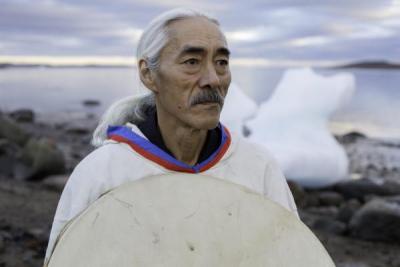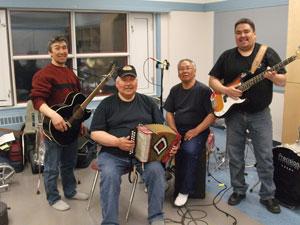Explore Arctic Music: Part III
By Michael QuigleyPart III: Pakak Innuksuk and Simeonie Keenainak
While some Inuit musicians push the boundaries of old and new styles, others reclaim and reinvigorate original Inuit sounds. In this third post of the Arctic Museum’s Inuit Music series, we’ll take a look at two master musicians who are passing their traditional skills and knowledge on to a younger generation.

While some Inuit musicians push the boundaries of old and new styles, others reclaim and reinvigorate original Inuit sounds. In this third post of the Arctic Museum’s Inuit Music series, we’ll take a look at two master musicians who are passing their traditional skills and knowledge on to a younger generation.
Pakak Innuksuk learned the North Baffin style of drum dance by watching performances by elders in the hamlet of Mittimatalik (formerly Pond Inlet), Nunavut, Canada. The drum was the only musical instrument in Inuit communities for thousands of years. Throughout the nineteenth and early twentieth centuries, however, colonial authorities often forbade its use.
Innuksuk encouraged the artform’s revival and continued to learn new techniques during the 1980s, when he helped to form a theater group which invited Inuit drummers to the community to perform and teach. Now considered a drum dance master, Innuksuk is teaching the younger generation, in part through collaboration with the Qaggiavuut Society, a performing arts organization based in Iqaluit, Nunavut.
In the Arctic Museum’s exhibit, A Resounding Beat: Music in the Inuit World, we featured the video “MASTER CLASS: NORTH BAFFIN DRUM by Pakak Innuksuk,” which you can find by scrolling through the Inuit Master Classes section of the Qaggiavuut website. Follow up with the subtitled interview on the same page, where the artist discusses his introduction to drumming, the colonial suppression of this misunderstood art, and the importance of engaging the youth in traditional culture.
A multitalented individual, Innuksuk is also an accomplished actor, hunter, drum maker, and carver. Discover more on his Qaggiavuut artist page here.
Though the accordion’s roots in the North American Arctic don’t go nearly as far back as those of the drum, once introduced, the instrument was eagerly adopted in many Inuit communities. Its sound remains in the North as a legacy of the cultural exchanges brought about through commercial whaling in the nineteenth century.
Simeonie Keenainak taught himself to play the accordion as a young boy by watching women in his community of Pangnirtung, Nunavut.

In an interview with Neco Cockburn for Ottawa Citizen, he explained, “It was only ladies who played accordion at that time, because all the men were too busy hunting to feed the family… During that time, there was one woman who played very good accordion. She played at square dances when they were waiting for the ship to arrive from the different communities… This woman was my role model. I got accordion music in me from then.”
Now a master accordion player himself, Keenainak also collaborates with the Qaggiavuut Society to preserve his traditional style and pass it on to future generations. You’ll find the video “Simeonie Keenainak from Panginirtung: Manamaasi,” which we featured in A Resounding Beat, under Qaggiavuut’s Inuit Master Classes. You can find more about him on his Qaggiavuut artist page here. Finally, get ready for some serious toe tapping and check out the short documentary Inngiruti – The Thing that Sings! On the National Film Board of Canada’s website.

an indispensable resource for Inuit performing arts, and they are currently accepting donations
to provide emergency relief for Inuit and Nunavut performing artists until federal funding becomes available. Learn more about their long-term vision and efforts to build a Qaggiq, a professional Nunavut Performing Arts and Cultural Learning Hub in Iqaluit here.